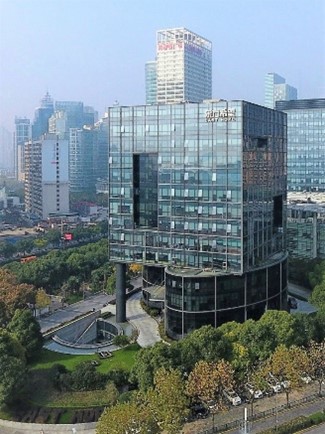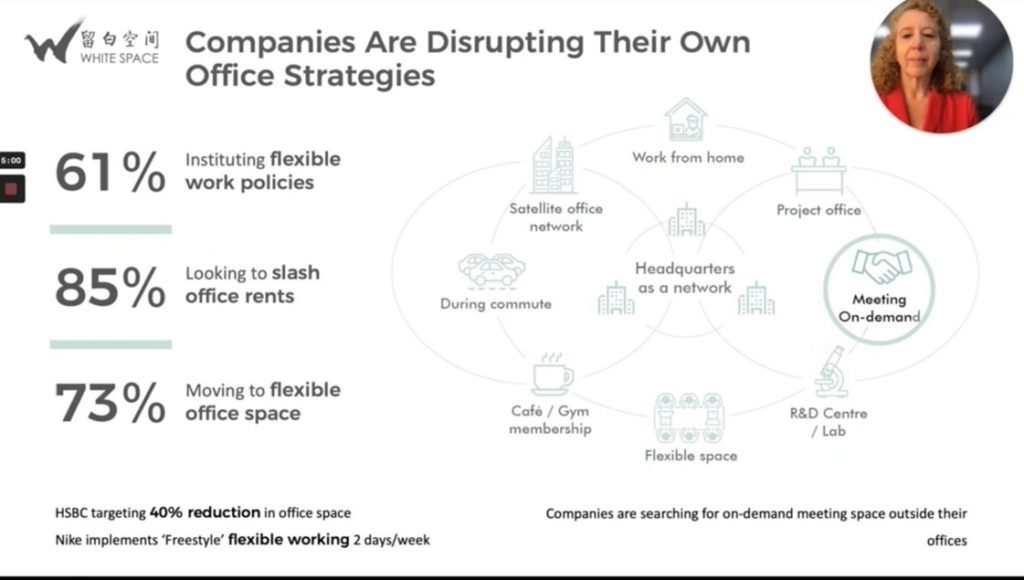Space as a Service might share the same acronym as SaaS, but it is opening up huge profitability potential for commercial real estate owners and users. Everyone is familiar with the SaaS model, software solutions licensed monthly to users generating vast revenue for its developers.
However, due to the changing needs of workers and how they utilise commercial real estate, WhiteSpace is scaling up its unique, flexible, on-demand collaboration space service.
This agile model is exactly in tune with the changed contemporary working pattern. Instead of committing to a set lengthy lease, companies can book both the period of time and size of the area they need to work or collaborate in. All of this was sped up by the pandemic, exposing the dire need for flexible working.
Pulling revenue from the void
WhiteSpace (留白空间) produces revenue for the empty office space owner in a creative commercial partnership. It has seen a strategic market fit and honed in on it. Building owners want to create revenue from voids, attract new tenants, and have a single trusted partner to deliver this.
With WhiteSpace, that might be a day where a company requires a breakout area with 80 people being trained by their new company, it might even be a week, but the model dovetails exactly to the shape and the needs of the hybrid workforce of today.
Barbara Ex, the founder of WhiteSpace, whose present operation is based across seven sites in the Shanghai region, realised even before the pandemic that the usual CRE model was changing. She said, “Asset owners need to wake up to the fact that this is a new future. The days of owning an asset and sitting back to collect rents for 20 years are over. Now you need to get involved in the operation.”

Barbara Ex saw that at one end of the spectrum office space owners were seeing declining occupancy, and they wanted more long-term tenants tied into the traditional lengthy contract model. At the other end were companies with specific needs who did not want to be tied down due to the fluid nature of their operations
“Everyone is looking for increased flexibility and relief from the high fixed costs of holding office space,” Barbara Ex said. “Work from home or remote work also means you need flexibility on where you do each type of work. Some kinds of work you might do as an individual working from home. Some types of work you might come into the office and have three or four meetings with different people in different departments.
“But when you have a sort of structured collaboration, like a workshop or training event, why do you have to go to either of those places? WhiteSpace provides an easily accessible third space, specialized for just that.”
The shape of the industry
Drilling down into the figures which WhiteSpace has, 61% of companies are instituting flexible work policies, 85% are looking to slash office rents and 73% are moving to Flexible office space. With all of this in the mix, the big question then is how does the WhiteSpace model aid and align with the needs of commercial property owners? After all, office vacancy rates locally in Shanghai are 16.9%, 13.2% in Beijing and 26.2% in Shenzhen.
As stated before, WhiteSpace generates new revenue for the empty office space owner in a win-win business tie-up. Commercial real estate owners want to create revenue from empty spaces, get new tenants, and have one delivery partner.
On the flip side, the ever demanding and business savvy clients of WhiteSpace want a private and professional environment that nurtures them, with the possibility of add on services and to pay only for what they need and use.
“Right now, what we’re doing is going into commercial buildings in the city centre and taking half a floor and splitting it into these flexible collaboration spaces, somewhere between, 20 and 100 square metres.”
With so many different models out there, Barbara Ex is quick to point out that her model is not just a Flex working model, it is a subset of this. For her, the on-collaboration space as a category delivered by WhiteSpace sits within the Flex model.

Asked to define what a collaboration space is, exactly, Barbara Ex says that it is a space for a group to come together to accomplish shared professional goals.
“[This] could be a workshop, or training, a meeting…it could be team building, new employee induction. All of these involve a group of people and a defined purpose for coming together.”
In a way, WhiteSpace has replaced those meetings in hotel foyers. Along with the huge concentration of people who come to buildings utilising WhiteSpace, they also generate substantial other benefits to the commercial asset owner.
An example is adding extra revenue for the ground floor retail and refreshment services within buildings due to the extra footfall. In addition to this, the higher occupancy demonstrates that the building is being utilised, therefore it is easier to rent office space if a prospective tenant does not think it is a building lacking life and energy.
WhiteSpace by the numbers
Across the WhiteSpace empire, over 1,600 meetings take place a month, while 10,000 new participants are using office buildings each week who would not normally be there, generating revenue for all of the stakeholders.
Like many seemingly ‘overnight’ successes, the company is based on decades of the founder’s personal experience, who (well before the pandemic) had tapped into the $1 billion global marketplace for ‘collaboration space’. This, at present, means eyeing yet further growth as options and finance come into focus, with 20% plus EBITA the long-term sustainable goal.

Asked if WhiteSpace is looking for investment to scale up, Barbara Ex says that like any founder her door is always open to anyone who wants to make contact. “In a way, we are in the space of after WeWork what happens now, and we have solved that problem.”
The secret to why this unique operation works is that CRE owners are, by their very nature, conservative and risk-averse, following a traditional model that has worked well for decades. As a result, they rarely look outside of the box. They rely on agents to find new tenants. But this model is failing.
WhiteSpace, as well as being the new SaaS in town, is also a lead generation, SEO packed B2B marketing phenomenon. Think digital networking and Key Account Management on a whole new scale. Driving new business life into unfilled, underutilised office buildings.
Whilst CRE owners worry about void office space in their buildings, WhiteSpace is on a constant charm offensive, hustling to attract different micro-staying clients who are attracted to an agile solution for their workforce. These clients have meetings that generate footfall of over 40,000 people a month across their sites.
Becoming a trusted partner
WhiteSpace is a trusted partner that the owner of the building deals with. there may be hundreds of meetings and thousands of new occupants milling around the buildings, but all of the logistics of this are dealt with by WhiteSpace. This means accountability and security.
It also means that traditional leases can still be assigned in buildings, as the two models do not compete. In fact, existing tenants in a building might utilise WhiteSpac, too, if for instance they need a breakout area and do not have one, or perhaps an event space.
The way Barbara Ex sums it up is, ‘We, the CRE owner and WhiteSpace, are selling a different product. It is like this: do you want a hotel room or do you want to buy a house? Two very different psychological buying processes and you have different criteria in what you’re looking for in those two very different products.
“The building owner wants a tenant for five, 10 or 15 years. But their tenants also want meeting space on demand. So I’m going to provide that for them. And while I’m providing that for them, we are filling office space.”
It is important to understand that WhiteSpace is not just for clients who are a new company or start-uplooking for a little extra space. It is a full-blown solution catering for three out of China’s top ten brands with their unique flex on-demand collaboration space service.
To illustrate the point, Barbara says, “It’s a niche in terms of usage, but if you think about it more deeply, our addressable market is every company in Shanghai. Because, at some point during the year, every company needs to have an event that doesn’t fit in their office.”
Clearly, the model is very much rooted in the shared economy model, where fewer people are intent on owning assets, instead focusing more on having them on demand when it suits them.
When asked if the nature work will revert to normal post-pandemic, Barbara Ex says, “What I do know is that we’re squarely in the middle of the macro trends in flexible working. Remote working folks are not going to go back to the way it was before, they crave and need a flexible solution. We are heading the charge in that space.”
Andrew Stanton is the founder and CEO of Proptech-PR, a consultancy for Founders of Proptechs looking to grow and exit, using his influence from decades of industry experience. Separately he is a consultant to some of the biggest names in global real estate, advising on sales and acquisitions, market positioning, and operations. He is also the founder and editor of Proptech-X Proptech & Property News, where his insights, connections and detailed analysis and commentary on proptech and real estate are second to none.












